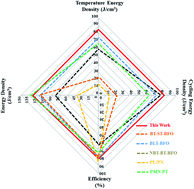Substantially improved energy storage capability of ferroelectric thin films for application in high-temperature capacitors†
Abstract
Ferroelectric thin films capacitors have been potentially applied in advanced electronics and electric power systems because of their high power densities and fast charge–discharge responses. However, continuous operation of the ferroelectric thin film capacitors under elevated temperatures and high electric fields still remains a huge challenge. Herein, we report eco-friendly BiFeO3-modified Bi3.15Nd0.85Ti2.8Zr0.2O12 (BNTZ) free-lead ferroelectric thin films for high-temperature capacitor applications that simultaneously possess high-energy storage density (Wreco), efficiency (η), and temperature-dependent stability. The BNTZ–0.09BFO thin film shows a first-class-level Wreco (∼124 J cm−3) along with high η (∼81.9%), which surpasses almost all the Pb-contained and Pb-free perovskite ferroelectrics. Of particular importance is that excellent fatigue endurance for long-term stability (109 cycles) and thermal stability (−100 °C to 200 °C) could be achieved. This work represents a new design paradigm to exploit advanced dielectric capacitor materials for high-temperature electronics and energy storage devices.



 Please wait while we load your content...
Please wait while we load your content...